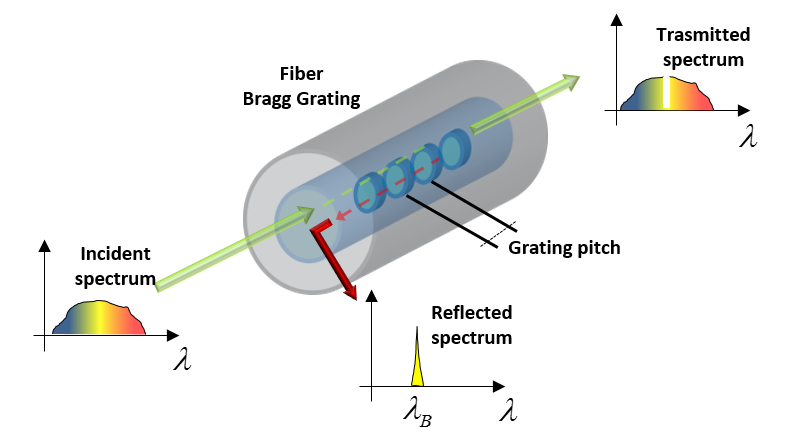FBG Technology Overview
The Fiber Bragg Grating (FBG) sensor is very high sensitive and versatile optical device for measuring several physical parameters including for example: strain, temperature, pressure, vibration and displacement. Since the first commercial FBG sensor (available in 1995) the technology has rapidly developed and today is available and extensively employed in a wide range of applications.
The FBG, in its simplest form, is a permanent periodic refractive index modulation inscribed in the optical fiber core exploiting photosensitivity. FBG based sensors exploit the presence of a resonance condition for which they reflect incident light at the so-called Bragg wavelength defined as:![]()
Where neff is the effective core refractive index of the fundamental mode and Λ is the grating pitch.
Today the FBG inscription techniques allow to create many types of reflectivity profiles making possible to realize sensors with a given values of peak reflectivity, bandwidth and side lobe level, adjusting the doping level and modulating amplitude and spatial pitch along the grating length through apodization and chirping techniques. Moreover, the possibility to “write” the Fiber Bragg Grating during the fiber optic production stage has allowed the mass production reducing the cost enabling also applications in large structures where a very high number of sensors is required. In addition, the introduction of advanced inscription techniques using Type-II, Type-IIA and regenerated FBG, fabricated by either ultraviolet lasers or femtosecond lasers, have allowed the production of FBG sensors for high temperature applications.

In FBG based sensors any change in either the effective refractive index or the grating pitch caused by external effects like local strain or temperature, will result in a Bragg wavelength shift, according to the formula:
![]()
Where ΔλB is the change in the Bragg wavelength, α and ς are the thermal expansion and thermo-optic coefficients, pε is the effective photo-elastic constant of the fiber material and ΔT, Δε are the applied temperature and longitudinal strain variations. Typical values of the wavelength shift due to temperature and strain variations are respectively: 11 pm/K and 1.2 pm/με for a grating with a resonance wavelength λB in the 1550 nm range.
The information about the parameters to be measured is directly encoded in a wavelength value, and this feature combined with the intrinsic properties of low attenuation and transmission capacity of the optical fiber allow for a robust signal detection even when very long distance separates sensors and control unit. The multiplexing techniques of FBG based sensors can be divided into the following categories:
- WDM (Wavelength Division Multiplexing): in which multiple FBG sensors can be cascaded in a single optical link using FBGs with different nominal center wavelengths
- TDM (Time Division Multiplexing): in which the response of individual sensors at the same nominal center wavelength along a single fiber link, can be identified according to the known signal time of flight.
A comparative analysis between traditional and FBG based sensor systems lead to the following considerations:
- The FBG sensors can be easily used in highly explosive and high electromagnetic radiation environments.
- The FBG based sensors are typically less invasive making easier to embed the sensors into civil and industrial complex structures.
- Thanks to their multiplexing capabilities, a monitoring system with a large number of sensors can be easily implemented.



